A Career Captain Dies and a Fire Fighter/Driver is Seriously Injured When Two Fire Trucks Collide at an Intersection - Connecticut
 Death in the Line of Duty…A summary of a NIOSH fire fighter fatality investigation
Death in the Line of Duty…A summary of a NIOSH fire fighter fatality investigation
F2007-17 Date Released: June 23, 2009
SUMMARY
On May 19, 2007, a 37-year old male career captain (the victim) was fatally injured when the engine he was riding in and a ladder truck collided at an intersection. Both apparatus were from the same department and were responding to a reported kitchen fire. A total of eight fire fighters were involved in the collision. According to the police report, the captain and the driver of the engine were not wearing seat belts. They were both ejected from the apparatus and suffered multiple critical injuries. The captain succumbed to his injuries three days after the collision and the driver remained hospitalized for several weeks. The six injured fire fighters were transported to local hospitals with non-life threatening injuries. Key contributing factors identified in this investigation include failure to stop at a red traffic signal and failure to wear seat belts.
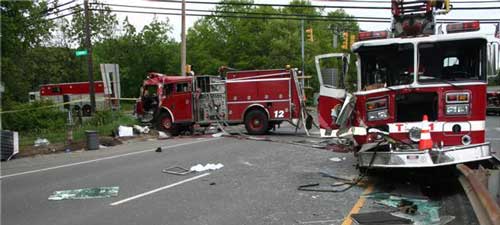 |
Final location of apparatus following the collision
|
NIOSH investigators concluded that, to minimize the risk of similar occurrences, fire departments should:
- establish, train on and enforce standard operating procedures (SOPs) that require drivers to stop at red traffic lights and stop signs, and proceed through intersections only after ensuring it is safe to continue
- enforce SOPs that require mandatory use of seat belts in all vehicles
Although there is no evidence that the following recommendations were contributory factors in this fatality, in accordance with prudent safety practice fire departments should:
- ensure their vehicle/apparatus maintenance program complies with applicable National Fire Protection Association (NFPA) standards and that all maintenance and repairs are performed by qualified technicians
- review procedures for all vehicles travelling in an emergency response to ensure safe travel and eliminate any chance of confusion at roadway intersections
Additionally, governing municipalities (federal, state, regional, and local) should:
- ensure that adequate line-of-site is maintained at roadway intersections, with an emphasis on routes routinely traveled by responding emergency vehicles/apparatus
- consider enacting legislation to include operators and occupants of fire department vehicles in existing seat belt legislation and/or repeal existing laws that exempt drivers and occupants of fire service vehicles from mandatory seat belt use
INTRODUCTION
On May 19, 2007, a 37-year-old male career captain (victim) was seated in the officer’s seat of an engine that was responding to a reported residential kitchen fire. While en-route, the engine collided at an intersection with a ladder truck from the same department that was responding to the same alarm. The impact from the collision and force of the resulting rotation caused the driver and the victim, who were not wearing seat belts, to be ejected from the apparatus. The driver suffered critical injuries and was hospitalized for several weeks and then transferred to a rehabilitation facility before returning home. The captain survived for three days but succumbed to his injuries on May 22. All remaining occupants were treated for non-life threatening injuries. On May 22, 2007, the National Institute for Occupational Safety and Health (NIOSH) was notified of this incident by the U. S. Fire Administration. On July 30, 2007, an investigation of this incident was conducted by a Safety and Occupational Health Specialist from the NIOSH Fire Fighter Fatality Investigation and Prevention Program. Meetings and interviews were conducted with the chief of the department, police officers who investigated the incident, the department vehicle maintenance supervisor, dispatch/communications staff, and fire department personnel who were involved in the incident or who were present on the scene. Copies of the department’s Standard Operating Procedures (SOPs), police report, training records, apparatus driver certification requirements, witness statements, death certificate, drawings of the incident scene, and photographs of the incident were reviewed.
FIRE DEPARTMENT
The career department involved in this incident employs approximately 240 uniformed personnel who serve a population of approximately 107,000 in a geographical area of about 30 square miles. The department is comprised of nine fire stations and their fleet includes one spare and ten first-line engine/pumpers, two spare and three first-line ladder trucks, and twenty-two other vehicles.
TRAINING and EXPERIENCE
The victim was a captain and had served in the same career department for approximately 12 ½ years. He had completed an extensive list of training that included Fire Fighter I and II, Live-fire, Hazmat, and Apparatus/Engine Operator.
To operate a vehicle over 26,000 pounds gross vehicle weight in the state where the incident occurred, a driver must first possess a valid automobile driver’s license with a “Q” restriction. A “Q” restriction is attained when the driver candidate successfully completes a three-part practical skills examination which is administered by the State Department of Motor Vehicles. Part 1 is a pre-trip inspection, Part 2 is a CDL static course, and Part 3 is a road test. Although fire apparatus drivers are exempted from this requirement, the department’s driver/operator program incorporated the state requirements into their formal emergency vehicle operator training program. The training is conducted using both a classroom and practical skills format. The practical skills component utilizes the NFPA 1002 Fire Apparatus Driver/Operator Professional Qualifications drivers’ course, the State Department of Motor Vehicles Commercial Drivers License (CDL) requirements, pre-trip inspection procedures and road test.1 Additionally, all candidates must successfully complete a written exam that is administered by the department and covers specific state statutes, department SOPs, and incorporates information from the state manual for drivers of commercial motor vehicles.
At the time of the collision, the drivers of both apparatus had been members of the department for approximately twelve years and had served as drivers after successfully completing the initial driver/operator training program within their first year. Training records show attendance at several subsequent driver training sessions. Numerous driver/operator training SOPs call for the use of seat belts at all times while riding in department apparatus or vehicles.
APPARATUS
Ladder 1 (L1), the truck involved in this incident, was a 1999 ladder truck that was purchased new the same year. It had a gross vehicle weight rating (GVWR) of 64,000 pounds. Following the collision, the police investigation found that L1’s weight of 58,000 pounds was within the manufacturer’s GVWR. A comprehensive mechanical inspection was performed on both units involved in the collision by the State Police, and no mechanical defects were found with L1.
Engine 12 (E12), the engine/pumper involved in this incident was a reserve unit that was activated while the regular engine was down for maintenance. It was an enclosed cab engine that was purchased new by the department in 1988 and used as a front line unit until 2006 when it was replaced by a new engine. It was designated as one of two reserve units on May 7, 2007, and was used by the department in that capacity until the day of the incident. The measured weight of E12 following the collision at 32,300 pounds was well within manufacturer specifications of 38,400 pounds GVWR. The mechanical inspection conducted by the State Police revealed braking deficiencies which would have caused the police to order that the engine be towed and stored until the brakes had been repaired. However, the police report stated that braking deficiencies were not a causal factor in the collision.
During the collision, E12 sustained heavy impact damage to the left front portion of the cab which bore the brunt of the collision. The driver’s door was completely detached from the cab. The right side passenger doors remained correctly positioned and functional. Both safety glass sections of the front windshield were broken out of the frame, but the center support column remained fixed. The driver’s seat remained connected to the metal pedestal floor support, but was bent slightly forward and down to the left. The officer’s bench seat had broken free from its anchors and was not equipped with an integrated self-contained breathing apparatus (SCBA) seat bracket.a According to the police report, both the driver’s and the officer’s seats were equipped with seat belts which appeared to be in good working order. An independent inspection, conducted by a nationally recognized consulting firm specializing in seat belt inspections, verified the police findings (Photo 1).
a A recessed area built into the seat back that would permit a fire fighter to sit completely back while wearing a self contained breathing apparatus.
MAINTENANCE PROGRAM
Apparatus/ vehicle maintenance was conducted in-house by the department’s Bureau of Automotive Repair (BAR). The BAR was staffed by a master mechanic and three staff mechanics. The master mechanic had completed training on specific job functions, but none of the maintenance staff had received formal nationally recognized or certified training in accordance with applicable NFPA standards.
Inspections were classified as either A, B, or C level, with A being a check of items such as fluid levels, tire pressure and a general equipment safety inspection. Level B included performing routine maintenance such as oil change, topping off fluids and a general safety inspection. The level C inspection was the most comprehensive and included A and B components plus a thorough check of the braking system. Maintenance procedures called for each apparatus to be serviced every twelve weeks by a rotating A, B or C inspection that followed a pre-planned schedule. According to information received during the investigation, front line apparatus received a class C inspection annually, but there were occasions when the interval between level C inspections for reserve/spare apparatus exceeded twelve months. According to the police report, department maintenance records revealed that Engine 12 underwent a level C inspection in March 2006 and maintenance was performed on the braking system in September 2006, December 2006 and January 2007. Documentation of all maintenance was handwritten and maintained manually with reports where no action was needed being discarded.
WEATHER / ROAD CONDITIONS
At the time of the incident the roadway was dry. The ambient air temperature was approximately 50º and the skies were clear with patchy cloud cover. Neither the weather nor the road conditions were contributory factors in the collision.
The route travelled by Ladder 1 was a state maintained public four-lane highway which runs in a north/south direction. There was a posted speed limit of 35 miles per hour (MPH) at the site of the collision. The asphalt surface was in good repair and was bordered by paved shoulders. The northbound shoulder was bordered by a wire guard rail system, but the southbound shoulder had no guard rail. In the immediate area of the collision, the roadway had two northbound and two southbound travel lanes that were both separated by dashed white lines and divided by a raised asphalt median. The median had a metal beam guard rail system running the length of the roadway. There was a separate turn lane for both northbound and southbound lanes at the intersection where the collision occurred.
Engine 12 was travelling on a two lane asphalt public side street that had a posted speed limit of 25 MPH. The street runs in an east/west direction and intersects with the north/south four-lane highway that was travelled by L1. This intersection, which is controlled by illuminated traffic signals, is where the collision occurred. The sight distance for both apparatus was very restricted by dense tree cover in the southeast quadrant of the intersection. Even though there is no research that quantifies the effectiveness of improving sight distance at signalized intersections, if there had been a clear line-of-sight, both drivers could have likely seen the other oncoming apparatus, had more time to react and slow their forward motion, thereby lessening the force of the impact or possibly avoiding the collision all together (Photos 2 and 3).
STATE REGULATIONS
In the state where the incident occurred, motor vehicle regulations provide exemptions for highway use of emergency vehicles as follows; Section 14-283, Rights of emergency vehicles, states that the operator of any emergency vehicle may: (A) proceed past any red light, stop signal, or stop sign, but only after slowing down or stopping to the extent necessary for the safe operation of such vehicle, (B) exceed the posted speed limits as long as such operator does not endanger life or property by so doing. The section further states that the provisions of this section shall not relieve the operator of an emergency vehicle from duty to drive with due regard for the safety of all persons and property.2
INVESTIGATION
On May 19, 2007, at 1032 hours, a resident placed a 911 call from her apartment to report a fire in the kitchen. The call was routed to the fire department dispatcher who requested specifics about the fire and asked if anyone was injured, if everyone was out of the building, and the location of the fire within the structure. The caller reported that there had been a fire in the oven in the kitchen and no one was injured. When the dispatcher questioned the caller specifically to verify that no one was injured and that the fire was out, the caller responded with “Yeah, I think so, yeah.” The address given by the caller was an apartment complex with 12 two-story buildings housing 82 apartments. Taking the type of occupancy into consideration, and the uncertainty of the caller, the decision was made to dispatch Engine 12, Engine 10, Car 5, Engine 11, Rescue 9, and Ladder 1, “code three” in accordance with fire service recommended practiceb and department protocol.
Also on the morning of May 19, 2007, a community blood drive was being sponsored by the International Association of Fire Fighters (IAFF) at the local union office. Engine 12, with a driver operator, a captain (the victim), and two fire fighters, and Rescue 9 with a fire fighter/driver, officer, and three fire fighters had gone to the blood drive to assist. At 1034 hours both units were dispatched to the possible kitchen fire and departed from the location of the blood drive. The driver of E12 chose to return to the area of his fire station and proceed to the fire location from a familiar direction, a route that took him through the intersection where the collision occurred. The Rescue 9 driver chose a route that by-passed the intersection and, according to the police report, was about 4/10 of a mile shorter in distance. Engine 10, with a driver/operator, an officer, and two fire fighters; a department sport utility vehicle (SUV) driven by a Deputy Fire Chief; and Ladder 1, with a fire fighter/driver, an acting officer, and two fire fighters were dispatched to the reported fire location and responded from their station which was south of the crash scene (Diagram 1).
Witnesses, who were in vehicles that were stopped at the intersection where the collision occurred, stated that Engine 10 passed northbound through the intersection on a green light. E10 was followed closely by the officer’s SUV which pulled over and stopped near the eastbound lane of the cross street where E12 was traveling westbound toward the red traffic signal. L1 was following the officer’s SUV and was estimated to be approximately 150 to 200 feet behind E10. For reasons unknown, E12 did not stop at the red light and entered the intersection traveling directly into the path of L1. The apparatus collided at the intersection with L1 impacting the left front of E12 causing it to rotate 180º clockwise, coming to rest facing east just north of the intersection. L1 continued forward following impact coming to rest with the left tires between the guard rail divider that separates the north and south lanes of the state highway (Photos 2 and 3, Diagram 2). The police crash reconstruction findings show that E12 rear brakes locked just prior to impact but there were no tire marks indicating pre-collision braking by L1. E12 was estimated by police to be travelling at ~18-25 MPH and L1 at 40-47 MPH at impact (Diagram 3). At 1038 hours, the Deputy Chief who was in the officer’s SUV called dispatch to report the collision.
The victim was wearing a SCBA and neither he, nor the driver, was wearing a seat belt. Both men were ejected from the apparatus, suffered multiple critical injuries, and were found lying on the paved shoulder of the state highway north of the intersection. The driver was hospitalized for several weeks and then transferred to a rehabilitation facility before returning home. The remaining six fire fighters, who were involved in the collision, received non-life threatening injuries and were transported to a local hospital where they were treated and released. The victim was transported to a local trauma center where he was treated before being transferred to a hospital where he died from his injuries on May 22, 2007.
b The Guide to IAFC Model Policies and Procedures for Emergency Vehicle Safety states that reported smoke or fire in a building would be classified as an emergency response.3 IFSTA Pumping Apparatus and Driver Handbook describes a non-emergency response as water shut-offs or covering an empty fire station.4
CONTRIBUTING FACTORS
Occupational injuries and fatalities are often the result of one or more contributing factors or key events in a larger sequence of events that ultimately result in the injury or fatality. NIOSH investigators identified the following items as key contributing factors in this incident:
- Failure to stop at a red traffic signal
- Failure to wear a seat belt
CAUSE OF DEATH
The office of the chief medical examiner listed the cause of death as blunt head trauma.
RECOMMENDATIONS
Recommendation #1: Fire departments should establish, train on and enforce standard operating procedures (SOPs) that require drivers to stop at red traffic lights and stop signs, and proceed through intersections only after ensuring it is safe to continue.
Discussion: NFPA 1500 states that during emergency response, drivers of fire apparatus shall bring the vehicle to a complete stop at red traffic lights and only proceed through the intersection when the driver can account for all lanes of traffic in an intersection.5 According to the police report, motor vehicle statutes in the state where the incident occurred permit emergency vehicles to proceed past any red light or stop sign, but only after slowing down or stopping to the extent necessary for the safe operation of the vehicle. The IAFF states that “Intersections present the greatest potential danger to emergency vehicles. When approaching a negative right-of-way intersection (red light, stop sign, or yield sign) the vehicle shall come to a complete stop and shall proceed only when the driver can account for all oncoming traffic in all lanes yielding the right-of-way.” 6 According to the police report and statements from witnesses who were stopped at the intersection, Ladder 1 had a green light, and Engine 12 had a red light but did not appear to attempt to stop prior to entering the intersection.
Recommendation #2: Fire departments should enforce SOPs that require mandatory use of seat belts in all vehicles.
Discussion: NFPA 1500, Standard on Fire Department Occupational Safety and Health Program states that all persons riding in fire apparatus shall be seated and belted securely by seat belts in approved riding positions at any time the vehicle is in motion. The standard further states that seat belts shall not be released or loosened for any purpose while the vehicle is in motion.5 Fire departments should develop, implement and enforce SOPs on the use of seatbelts in accordance with National Fire Protection Association (NFPA) guidelines. Numerous nationally recognized fire service entities have guidance available on implementing a seat belt policy. The International Association of Fire Fighters (IAFF) provides guidance in their document Fire Department Vehicle Safety, Emergency and Non-Emergency Response, and Safe Emergency Operations on Roadways, 6 and recommends that all employees use seat belts at all times and “All personnel shall ride only in regular seats provided with seat belts. The company officer and driver of the vehicle shall confirm that all personnel and riders are on-board, properly attired, with seat belts on, before the vehicle is permitted to move. This confirmation shall require a positive response from each rider.” The International Association of Fire Chiefs (IAFC), Guide to IAFC Model Policies and Procedures for Emergency Vehicle Safety, states that “The driver shall not begin to move the vehicle until all passengers are seated and properly secured. All passengers shall remain seated and secured as long as the vehicle is in motion. Seat belts shall not be loosened or released while en-route to dress or don equipment.” 2 NFPA 1901, Standard for Automotive Fire Apparatus, establishes requirements for the minimum length of seat belts, together with how they are measured. The standard also recommends that a seat belt warning device be installed to indicate when seat belts are not being properly used.7
According to the police report, no one in the engine was wearing a seat belt. The victim and the driver were ejected from the engine and were critically injured. The fire department’s SOP on seat belts states that all personnel shall be properly secured to the vehicle (safety restraint, seat belts, etc.) before leaving the station and personnel are not allowed to don or wear a SCBA unless it is in an approved recessed bracket. A review of department records revealed evidence of seat belt enforcement, including implementation of disciplinary procedures, however, enforcement of any SOP, including seat belts, must be constantly and consistently trained upon, implemented and enforced. For guidance, increased awareness, and a show of commitment to the enforcement of seat belt usage, fire departments should consider recommending that members participate in the National Seat Belt Pledge.8
If the driver and captain (the victim) in Engine 12 had been wearing their seat belts, it is possible that they would not have been ejected from the apparatus, and that their injuries may not have been as severe or fatal.
Although there is no evidence that failure of the following were contributory factors in this fatality, in accordance with prudent safety practice fire departments should consider these recommendations.
Recommendation #3: Fire departments should ensure their vehicle/apparatus maintenance program complies with applicable National Fire Protection Association (NFPA) standards and that all maintenance and repairs are performed by qualified technicians.
Discussion: NFPA 1911, Standard for the Inspection, Maintenance, Testing, and Retirement of In-Service Automotive Fire Apparatus states that all fire apparatus that could be placed in service for emergency response shall be inspected, maintained, tested, and retired as required to keep them in safe operating condition and ready for response at all times. Maintenance schedules should be established and recorded as an integral part of a well-planned maintenance program.9 The maintenance program should include daily, weekly, and periodic maintenance service checks. Safety and operational readiness need to be the highest priority when inspecting and maintaining vehicles. NFPA 1911 also recommends that information from several sources, including the manufacturer’s manuals and NFPA standards, be used to determine fire apparatus preventative maintenance schedules. As the necessary maintenance tasks are identified each should be assigned a schedule based on months, years, hours, or some other time frame that will determine when it is to be performed and by whom. Once the tasks to be performed, their required frequency, and who will do the work have been identified, the preventive maintenance program can be organized into a series of schedules, check sheets, record sheets, and other documentation that will ensure correct implementation of the program.
Establishing a system for retaining records is an important component of an apparatus maintenance program. All service records, whether an issue is identified or not, should be maintained according to the individual vehicle and kept for the life of the apparatus. In many cases, problems can only be found by comparing current test results with previous test results. To assist in detecting maintenance problems, and determining when an apparatus has reached the end of its’ useful service life, it is important that maintenance records be well organized, thorough, and available for review.
NFPA 1071, Standard for Emergency Vehicle Technician Professional Qualifications, applies to personnel who are engaged in the inspection, diagnosis, maintenance, repair, and testing of emergency response vehicles.10 This standard identifies and defines the minimum job performance requirements (JPR) for a person to be considered qualified as an emergency vehicle technician (EVT) and outlines requirements for qualification. The standard defines methods for evaluating emergency vehicle technician qualifications which include schooling, training, practical experience, and existing certification programs. Programs such as Automotive Service Excellence (ASE),11 the Emergency Vehicle Technicians Certification Commission (EVT),12 or a technician certification program recognized by a federal or state agency, or equivalent, can be utilized to help determine the requisite knowledge and skills of a maintenance technician candidate.
NFPA 1071, Annex A, states that there are certain components on emergency response vehicles that are not considered unique and it is not the intent of the standard to restrict departments from using persons they feel are qualified to perform inspection, diagnosis, maintenance, repair, and testing of those components. However, an emergency response vehicle is a complex piece of machinery and there are many components that are highly integrated. Because of this complexity, this standard requires that a person qualified as an emergency vehicle technician possess minimum skills and knowledge to inspect, diagnose, and perform repairs.10
At the time of the incident, mechanics who serviced the fire apparatus had experience and some training, but were not certified emergency response vehicle technicians as recommended and defined by NFPA 1071, Standard for Emergency Vehicle Technician Professional Qualifications. 10
Recommendation #4: Fire departments should review procedures for all vehicles travelling in an emergency response to ensure safe travel and eliminate any chance of confusion at roadway intersections.
Discussion: Conversations with various fire service personnel reveal an emergency response practice where a department vehicle, such as an officer’s car, will drive into an intersection ahead of an apparatus when it encounters a red light. This is done to stop opposing traffic that is traveling through a green light, and thereby permit the emergency apparatus to pass through the red light without stopping. During this emergency response, the officer had been traveling ahead of Ladder 1 and behind Engine 10 on the four lane state highway when he performed a common maneuver by pulling out of the northbound travel lane and onto the east side of the intersection to let the ladder truck pass. The officer pulled diagonally into the intersection near the eastbound lane of the east/west side street where Engine 12 was approaching the traffic light from the west (Diagram 2). Although there is no evidence that this was a contributory factor in the collision, if using department vehicles to stop opposing traffic at intersections is a common practice, the appearance of a department vehicle at an intersection could possibly cause confusion.
In many jurisdictions, enforcing traffic rules and regulations is the responsibility of law enforcement, and therefore the practice of fire department personnel blocking intersections as described above may be unlawful. This procedure is also counter to safety recommendations set forth by numerous fire safety entities including NFPA 1500, IAFF, and the IAFC, which state that all apparatus must come to a complete stop at all stop signs and red lights, and only continue through the intersection after ensuring it is safe to proceed.3,5,6
NFPA 1451, Standard for a Fire Service Vehicle Operations Training Program states that, “the authority having jurisdiction shall establish emergency response procedures to minimize travel times, optimize response safety, and minimize the chance of emergency vehicles meeting at traffic intersections. When multiple fire service vehicles are responding to an emergency incident from different locations, the drivers shall coordinate their intended response routes to prevent the response vehicles from colliding at road intersection.”13 Responding units should maintain dialogue between each other and dispatch to help eliminate route-of-travel complications and confusion during an emergency response. SOPs should call for radio reports of apparatus location and status, particularly when approaching the same intersection. 4
In this incident, E12 was approaching the intersection from an unexpected direction because they were dispatched from the blood drive location and not the station. R9 and E12 left the blood drive at approximately the same time but travelled to the call via different routes. The R9 driver traveled a route which crash investigators found to be approximately 4/10ths of a mile shorter than the route the E12 driver intended to take that took him back toward his station before proceeding to the call (Diagram 1). Discussions with fire service personnel revealed that it was not uncommon for fire apparatus drivers to return to the area of their station, and respond to an emergency call via a familiar route when they are out of, but near to, the station. Those same discussions also revealed that fire apparatus drivers may disregard what appears to be a logical path of travel and take a more indirect route to a call to facilitate on-scene staging and placement of fire apparatus, to ensure optimum fire suppression capabilities and incident scene management. Under normal circumstances, it is unlikely that E12’s chosen path of travel would have impacted the outcome of the fire call.
Recommendation #5: Governing municipalities (state, regional, local) should ensure that adequate line-of-site is maintained at roadway intersections, with an emphasis on routes routinely traveled by responding emergency vehicles/apparatus.
Discussion: Line-of-sight for motorists is one of the most important safety issues at an intersection. The ability of drivers to be able to see approaching traffic to determine if it is safe to enter the intersection is critical. According to the State Highway Design Manual, which is issued by the state where the incident occurred, “traffic signals should not be an alternative to providing adequate sight distance.”14 Areas along the approach to an intersection and across the corners should be clear of obstructions that might block the driver’s view of approaching traffic. In this incident, line-of-sight at the intersection was severely obstructed by tree foliage and although there is no evidence this directly caused the collision, the obstructed view likely prevented the drivers from seeing each other thereby causing a delay in their reaction time to the impending collision (Photo 2, Diagram 3).
The American Association of State Highway and Transportation Officials/National Cooperative Highway Research Program (ASSHTO/NCHRP) Strategic Highway Safety Plan15 states that when trees are allowed to grow in the sight triangle it can obstruct drivers’ view of oncoming vehicles. The distances designated as “a” and “b” in diagram four are often set by local ordinances, based upon the speed limit, obstructions, and road geometry, and typically place height restrictions on objects in the sight triangle. Nationally recognized highway and transportation entities such as The American Association of State Highway and Transportation Officials (AASHTO),16 and the National Cooperative Highway Research Program (NCHRP),17 provide guidance on proper intersection design and methods to calculate safe line-of-sight distances at roadway intersections (Diagram 4). Many state and local municipalities have developed specific ordinances outlining sight distance and roadway configuration recommendations for roadway intersections which are within their jurisdiction.
Professional crash investigators were unable to create an exact reconstruction of the incident due to insufficient data on fire apparatus collisions that could be used for reference and/or comparison. However, police investigators used several methodologies to develop line-of-sight, speed, and stopping distance scenarios for the collision. By utilizing incident scene findings and witness statements, the impact speed of E12 was estimated to be 18 to 25 MPH, and L1 to be 40 to 47 MPH. Approximate apparatus speed and placement at first sight are depicted in Diagram 3. Even though there is no research that quantifies the effectiveness of improving sight distance at signalized intersections, if both drivers had a clear line-of-sight at the intersection their reaction time likely would have increased giving them more time to apply the brakes, and the collision may have been less severe and possibly could have been avoided.
Recommendation #6: Governing municipalities (federal, state, regional, and local) should consider enacting legislation to include operators and occupants of fire department vehicles in existing seat belt legislation and/or repeal existing laws that exempt drivers and occupants of fire service vehicles from mandatory seat belt use.
Discussion: Vehicle crashes are consistently the second leading cause of fire fighter line-of-duty deaths. Information found in the Connecticut Department of Transportation website outlines the need for passenger car seat belt use and states that when seat belts are used properly, the number of serious traffic injuries can be reduced as much as 50% and fatalities reduced by 60 – 70%.18 However there is no state-mandated seat belt requirement for operators and occupants of fire department vehicles and apparatus. The Federal Motor Carrier Safety Administration also exempts the occupants of fire trucks and rescue vehicles while involved in emergency and related operations from wearing seat belts.19 These laws are in direct opposition to NFPA standards, and IAFC and IAFF recommendations as mentioned previously.3,5,6 Governing entities should consider enacting legislation that would place seat belt requirements on drivers and occupants of fire department vehicles and apparatus.
REFERENCES
- NFPA [2003]. NFPA 1002, Standard for a fire department vehicle driver/operator professional qualifications. Quincy, MA: National Fire Protection Association.
- State of Connecticut [2005].General Statutes of Connecticut, Title 14 Motor Vehicles. Use of the Highway by Vehicles.external icon Gasoline.[http://www.cga.ct.gov/current/pub/chap_248.htm#sec_14-283] Date accessed: March 2009. (Link Updated 1/8/2013)
- Guide to IAFC Model Policies and Procedures for Emergency Vehicle Safety.pdf iconexternal icon [http://www.iafc.org/files/1SAFEhealthSHS/VehclSafety_IAFCpolAndProceds.pdf] Date accessed: February 2009. (Link Updated 10/28/2013)
- IFSTA [1999]. Pumping apparatus driver/operator handbook. Stillwater, OK: International Fire Service Training Association. National Fire Protection Association [2000]. NFPA 1915, Standard for fire apparatus preventive maintenance program. Quincy, MA: National Fire Protection Association.
- NFPA [2007]. NFPA 1500, Standard on Fire Department Occupational Safety and Health Program. Quincy, MA: National Fire Protection Association.
- IAFF [2008] International Association of Fire Fighters, Fire Department Standard Operating Procedure, Fire Department Vehicle Safety, Emergency and Non-Emergency Response, Safety Emergency Operations on Roadwayspdf iconexternal icon. [http://iaff.org/hs/evsp/Vehicle%20Safety%20SOP.pdf] Date accessed: February 2009. (Link Updated 1/17/2013)
- NFPA [2003]. NFPA 1901, Standard for automotive fire apparatus. Quincy, MA: National Fire Protection Association.
- United States Fire Administration. USFA, National seat belt pledge [http://www.trainingdivision.com/seatbeltpledge.asp]. Date accessed: February 2009. (Link no longer available 1/8/2013)
- NFPA [2007]. NFPA 1911, Standard for the inspection, maintenance, testing, and retirement of in-service automotive fire apparatus. Quincy, MA: National Fire Protection Association.
- NFPA [2006]. NFPA 1071, Standard for emergency vehicle technician professional qualifications. Quincy, MA: National Fire Protection Association.
- Automotive Service Excellence.external icon (ASE) [https://www.ase.com/Home.aspx], Date accessed: February 2009. (Link updated 4/9/2013)
- Emergency Vehicle Technicians Certification Commissionexternal icon (EVTCC) [http://www.evtcc.org], Date accessed: February 2009.
- NFPA [2007]. NFPA 1451, Standard for a fire service vehicle operations training program. Quincy, MA: National Fire Protection Association.
- Connecticut Department of Transportation [2003 Ed. 2006 Revisions] Highway design manual.pdf iconexternal icon [http://www.ct.gov/dot/lib/dot/documents/dpublications/highway/cover.pdf]. Date accessed: February 2009. (Link Updated 1/8/2013)
- The American Association of State Highway and Transportation Officials/ National Cooperative Highway Research Program AASHTO/NCHRP, Strategic highway safety planexternal icon. [http://safety.transportation.org]. Date accessed: February 2009.
- The American Association of State Highway and Transportation Officialsexternal icon (AASHTO). [http://www.transportation.org/Pages/default.aspx]. Date accessed: February 2009. (Link Updated 1/17/2013)
- National Cooperative Highway Research Programexternal icon (NCHRP) [http://www.trb.org/NCHRP/NCHRP.aspx]. Date accessed: February 2009. (Link Updated 1/17/2013)
- Connecticut Department of Transportation external icon[2009]. [http://www.ct.gov/dot/cwp/view.asp?a=1388&q=259430&pp=12&n=1]. Date accessed: March 2009
- Federal Motor Carrier Safety Administrationexternal icon [2009]. [http://www.fmcsa.dot.gov/rules-regulations/rules-regulations.htm]. Date accessed: March 2009
INVESTIGATOR INFORMATION
This incident was investigated and report authored by Virginia Lutz, Safety and Occupational Health Specialist, NIOSH, Division of Safety Research, Surveillance and Field Investigation Branch, Fire Fighter Fatality Investigation and Prevention Program. An expert technical review was provided by Mike Wilbur, nationally recognized expert in emergency vehicle operations and co-editor of www.EmergencyVehicleResponse.comexternal icon.
PHOTOS AND DIAGRAMS
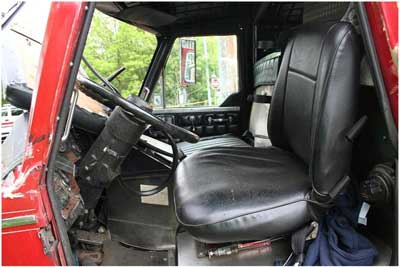
|
Photo 1. Engine 12 cab interior viewed from the driver’s side.
|
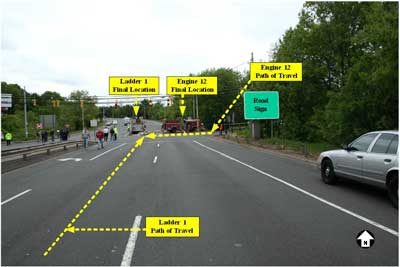
|
Photo 2. Showing the apparatus path of travel, final location after collision, and trees that created a line-of-sight obstruction,
|
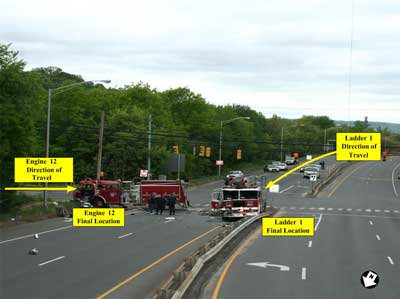
|
Photo 3. Apparatus direction of travel and final location after collision
|
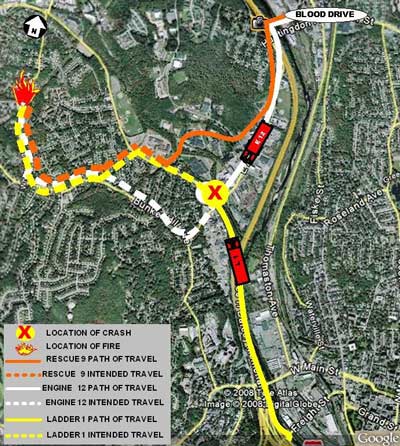
|
Diagram 1. Aerial view depicting path of travel for L1, E12 and R9
|
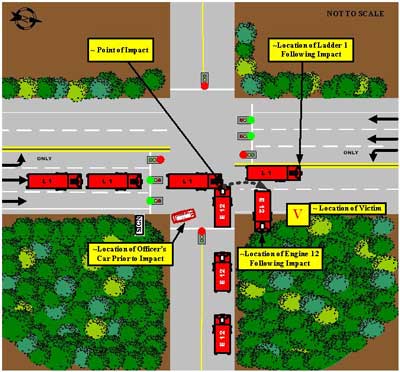
|
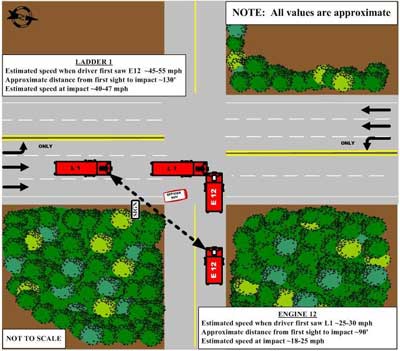
|
Diagram 3. Aerial view depicting line-of-sight and approximate
|
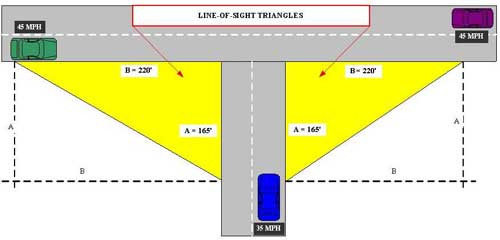 |
Diagram 4. Depiction of calculations used to determine intersection
|
|
The National Institute for Occupational Safety and Health (NIOSH), an institute within the Centers for Disease Control and Prevention (CDC), is the federal agency responsible for conducting research and making recommendations for the prevention of work-related injury and illness. In fiscal year 1998, the Congress appropriated funds to NIOSH to conduct a fire fighter initiative. NIOSH initiated the Fire Fighter Fatality Investigation and Prevention Program to examine deaths of fire fighters in the line of duty so that fire departments, fire fighters, fire service organizations, safety experts and researchers could learn from these incidents. The primary goal of these investigations is for NIOSH to make recommendations to prevent similar occurrences. These NIOSH investigations are intended to reduce or prevent future fire fighter deaths and are completely separate from the rulemaking, enforcement and inspection activities of any other federal or state agency. Under its program, NIOSH investigators interview persons with knowledge of the incident and review available records to develop a description of the conditions and circumstances leading to the deaths in order to provide a context for the agency’s recommendations. The NIOSH summary of these conditions and circumstances in its reports is not intended as a legal statement of facts. This summary, as well as the conclusions and recommendations made by NIOSH, should not be used for the purpose of litigation or the adjudication of any claim. For further information, visit the program website at www.cdc.gov/niosh/fire or call toll free 1-800-CDC-INFO (1-800-232-4636).
|
This page was last updated on 06/23/09.
